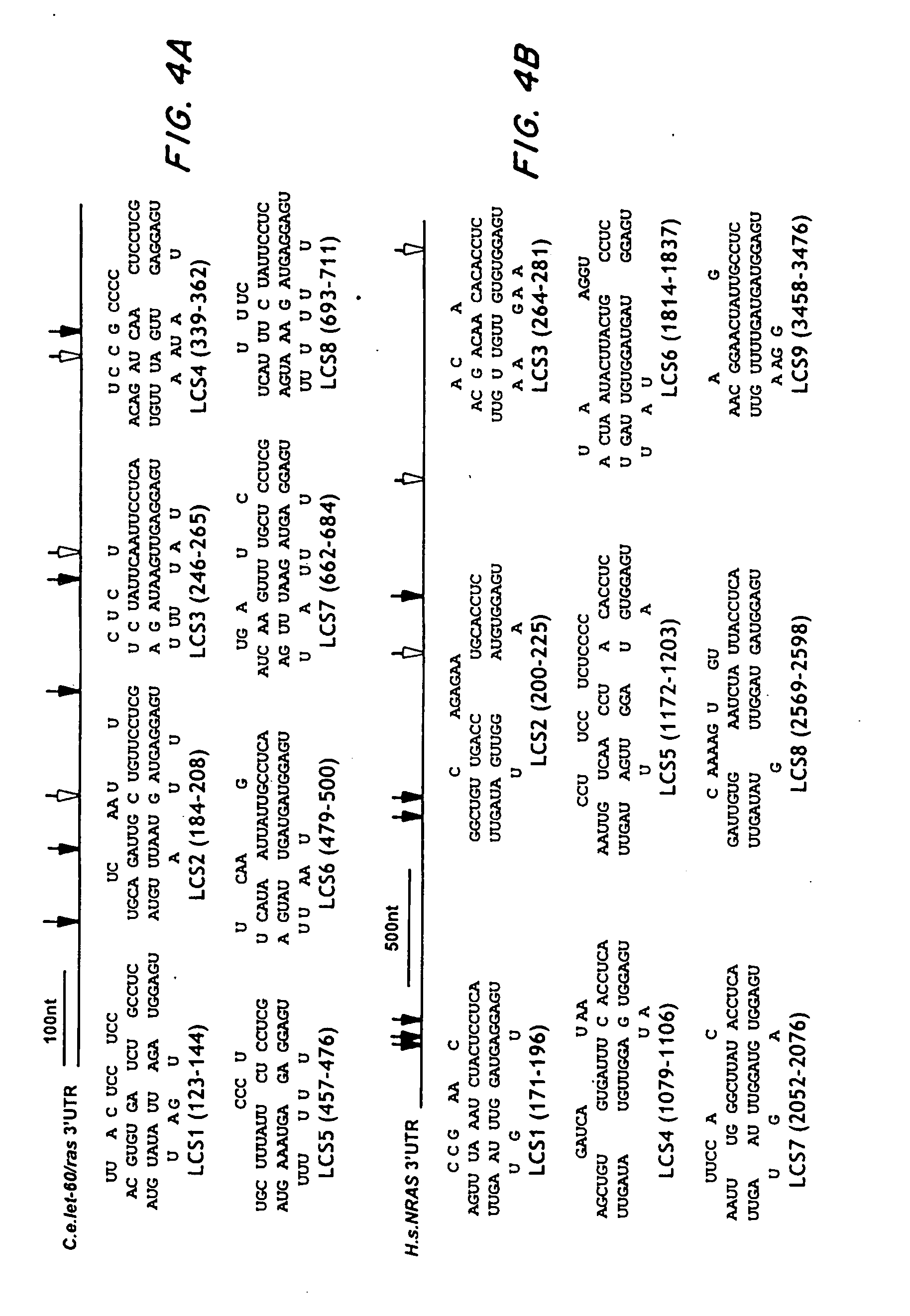Regulation of oncogenes by microRNAs
a technology of oncogenes and micrornas, which is applied in the direction of peptide/protein ingredients, drug compositions, muscular disorders, etc., can solve the problems of poor survival rate of patients, cancer deaths for both men and women, and misregulation of genes, so as to inhibit the expression of ras, myc, and/or bcl-2, and reduce tumor size. , the effect of inhibiting the expression of one or more oncogenes
- Summary
- Abstract
- Description
- Claims
- Application Information
AI Technical Summary
Benefits of technology
Problems solved by technology
Method used
Image
Examples
example 1
RAS is Regulated by the let-7 microRNA Family
[0148]C. elegans let-7, mir-48, mir-84 and mir-241 encode four developmentally regulated miRNAs that comprise the let-7 family (Lau et al., (2001) Science 294, 858-862; Lim et al., (2003) Genes Dev 17, 991-1008; Reinhart et al., (2000) Nature 403, 901-906). This family displays high sequence identity, with particular conservation at the 5′end of the mature miRNAs (FIG. 10A, 10B). The C. elegans let-7 family miRNAs, mir-84, plays a role in vulval development, a model for dissecting RAS / MAP Kinase. signaling (Wang and Sternberg, (2001) Curr Top Dev Biol 51, 189-220). C. elegans let-60 / RAS is regulated by members of the let-7 family. let-7 and mir-84 are complementary to multiple sites in the 3′ UTR of let-601RAS. let-7 and mir-84 are expressed in a reciprocal manner to let-60 / RAS in the hypodermis and the vulva respectively.
[0149] let-7 and mir-84 genetically interact with let-60 / RAS, consistent with negative regulation of RAS expression ...
example 2
Expression Patterns of let-7 and mir-125, the lin-4 Homologue
[0184] It was found that both let-7 and mir-125, the lin-4 homologue, are expressed in a variety of adult tissues, with prominent expression in the lung and brain. Interestingly, both are expressed at low levels in the pancreas and testis. Past work has shown that the C. elegans lin-4 and let-7 miRNAs are temporally expressed (Reinhart, B., et al., (2000) 403:901-906 and Feinbaum, R. and V. Ambros, (1999) Dev Biol 210(1):87-95). Similarly, it has been shown that the mammalian homologues for these miRNAs are also temporally expressed during mouse development. Northern blots reveal that let-7 and mir-125 have very similar expression profiles. Both become expressed at around day E9.5. Interestingly, this coincides approximately with the time of lung organogenesis, and when other major organs begin to develop.
[0185] An in situ protocol using an oligonucleotide based on the mouse sequence of the let-7c miRNA, which has been d...
example 3
Effect of Inhibition and Overexpression of let-7 in Lung Cancer Cells
[0186] Inhibition of let-7 function in A549 lung cancer cells via transfection (with anti-let-7 molecules) causes increased cell division of A549 lung cancer cells (FIG. 18A), while let-7 over-expression (with transfected pre-let-7) caused a reduction in A549 cell number (FIG. 18B). These results are consistent with the tumor suppressing activity of let-7. Moreover, the let-7 over-expression phenotype resembled that caused by MYC down-regulation (FIG. 18A), suggesting that the effects of let-7 on cell proliferation may also be through repression of MYC. Preliminary evidence indicates that MYC is also a direct target of let-7 in human cells. Therefore, these results indicate that let-7 may be a potential therapeutic in cancers with aberrant expression of MYC.
PUM
| Property | Measurement | Unit |
|---|---|---|
| Length | aaaaa | aaaaa |
| Sensitivity | aaaaa | aaaaa |
Abstract
Description
Claims
Application Information
 Login to View More
Login to View More - R&D
- Intellectual Property
- Life Sciences
- Materials
- Tech Scout
- Unparalleled Data Quality
- Higher Quality Content
- 60% Fewer Hallucinations
Browse by: Latest US Patents, China's latest patents, Technical Efficacy Thesaurus, Application Domain, Technology Topic, Popular Technical Reports.
© 2025 PatSnap. All rights reserved.Legal|Privacy policy|Modern Slavery Act Transparency Statement|Sitemap|About US| Contact US: help@patsnap.com



